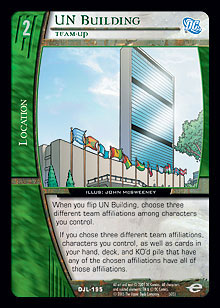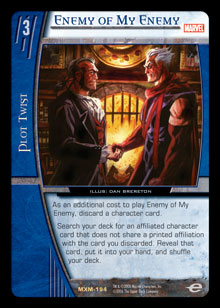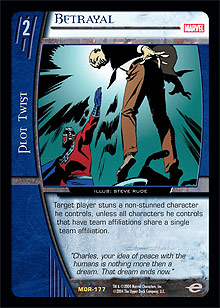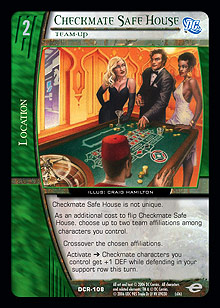By the time this article is published, Halloween will have come and gone. Halloween is one of my favorite holidays of the year. It allows me to eat as much candy as I want and not get in trouble for it. There are also all the scary movies, haunted houses, and random people in costume to keep you entertained. Recently, my wife had to carve up a pumpkin for a pumpkin contest at work. She had me print a complicated design for her so that when she got home from work, she could carve it out. When she started doing it, I noticed that she was pressing too hard on the pumpkin and carving it really thin. I told her that she might need to carve it a little thicker, but she said that she had to do it herself because she was entering the pumpkin in a contest. She ended up breaking off a key piece of her pumpkin and not even entering the contest.
So, what on Earth does that story have to do with Vs. System? The answer is very basic, really. While some decks can “do it themselves,” it is often better to team them up to help accomplish certain objectives. This article’s intent is to take you through the concept of teaming-up: when it is useful, and when it may not be so useful.
Teaming-Up: Flavor or Fortune?
One thing I always tell people is that UDE did a bang-up job transferring the concept of teams into the game. I know that some individuals play this game for the sole reason of replaying comic book battles they read as kids. It’s often these individuals who have the hardest time grasping competitive play because to them, it seems “unnatural” that Dr. Doom would ever team-up with Superman or the like. But doing so is generally the next step in competitive play—that is, going beyond a deck that is pre-built with team-stamped characters, plot twists, and locations. Before we delve into the benefits and drawbacks that teaming-up has to offer, let’s consider how it has shaped the game so far.
In the beginning, UDE made specific team-ups that encouraged playing certain teams together, such as Common Enemy and My Beloved. It shouldn’t come as much of a surprise that both of these cards were present in tournament-winning decks (Pro Circuit Indy 2004 and $10K Las Vegas 2005, respectively). While the individual teams present in each deck archetype were strong, each team needed a little extra edge from the other to be tournament worthy. I will concede that the Fantastic Four and Doom teams are still viable in Golden Age, but I personally feel that Common Enemy contained all the strengths both teams had to offer in one comprehensive deck.
 This was the beginning of team-up decks. For a while, I remember first looking to see which teams UDE printed team-ups for, as I felt they were trying to lead players to good deck choices. Unfortunately, as more sets were released, UDE couldn’t continue to make legacy cards solely devoted to team-ups. This is when cards like UN Building and Metropolis were released. At this point, it was up to the player to determine which teams fit with each other, and you really saw the creative juices start to flow. Players like Jason Hager took full advantage of this creativity and came up with interesting decks like the original Evil Medical School. This deck focused on a team-up of Gotham Knights, Fearsome Five, and Doom, with splashes from other teams like Darkseid’s Elite.
This was the beginning of team-up decks. For a while, I remember first looking to see which teams UDE printed team-ups for, as I felt they were trying to lead players to good deck choices. Unfortunately, as more sets were released, UDE couldn’t continue to make legacy cards solely devoted to team-ups. This is when cards like UN Building and Metropolis were released. At this point, it was up to the player to determine which teams fit with each other, and you really saw the creative juices start to flow. Players like Jason Hager took full advantage of this creativity and came up with interesting decks like the original Evil Medical School. This deck focused on a team-up of Gotham Knights, Fearsome Five, and Doom, with splashes from other teams like Darkseid’s Elite.
UDE continued to give players options in teaming-up, but instead of simply saying that Team X must team-up with Team Y, they started making open-ended team-ups like Midnight Sons and Coercion. Both of these cards allowed you to get a team-up online without ever actually having to put the other team into play. When compared to the original team-ups that told you which teams you could put together, these cards were almost a full 180° from where the team-up cards started.
Why Team-Up: Benefits but No 401(k)
There you have a brief history of team-ups in Vs. System. How is that supposed to help you become a better player? Simple. You need to be able to recognize that in many situations, one team is not as strong as two (or more, for that matter). I remember a wedding I went to where it was said that one strand of thread is easily broken, but two woven together are much more difficult to cleave. This is true in Vs. System as well.
I want to be clear that I am not trying to tell you that every deck should consist of multiple teams. Instead, I want you to consider what adding a team might do to further the goals of your deck.
Consistency
 I have been spending a lot of time lately talking about consistency in regard to deck choices and competitive play in general. In my opinion, this is one of the most important aspects of deck construction. If you don’t have a consistent deck, you have a pile of cards. It only makes sense that one of the biggest benefits you get from teaming-up is consistency because there are not many bigger benefits available.
I have been spending a lot of time lately talking about consistency in regard to deck choices and competitive play in general. In my opinion, this is one of the most important aspects of deck construction. If you don’t have a consistent deck, you have a pile of cards. It only makes sense that one of the biggest benefits you get from teaming-up is consistency because there are not many bigger benefits available.
The best example of this is Enemy of My Enemy. I don’t think I have to tell you that Enemy of My Enemy is the best card out there if you want to improve consistency; however, this card requires you to run multiple teams. So, if you want to use this incredibly powerful card, you will have to think outside the box a little bit and try to find other teams and characters that aid you in your objectives as a deckbuilder.
While Enemy of My Enemy may be the universally accepted team-up card of choice, there are certainly others that provide consistency as well. Cards like Signal Flare, Bat-Signal, Wild Ride, Brother I Satellite, and Hero’s Welcome just scratch the surface of the available would-be curve smoothers. It is up to you as up-and-coming deck builders to determine which ones will suit your purposes the best.
Unique Themes
If you aren’t teaming-up for consistency, then the next natural reason to add an additional team to your deck is that it fits in with what you are trying to accomplish. Take the High Voltage deck, for example. While it doesn’t run team-ups, per se, it does run many characters that further its theme of burn (such as Golden Archer; Electric Eve; and Firestar, Hellion).
It’s always a good idea to develop a theme within a particular deck, but most of the time one team doesn’t provide enough options to realize that theme fully. If you look to other teams, you will find more answers and choices than you would have if you had stayed mono-team.
Curve Filling
One of the original reasons for running a team-up deck was to fill the curve. Sometimes, you just need a big body at a certain drop. A friend of mine recently asked me if Common Enemy would be viable in the upcoming Golden Age. I asked him why a person would team-up with Fantastic Four. It was my opinion that the only reason that Doom even teamed-up with Fantastic Four was to gain access to Signal Flare. My friend responded by saying that characters like Thing, Heavy Hitter; She-Hulk, Jennifer Walters; and She-Thing were still good for a change of pace in the deck and provided the offensive threat necessary to win. I think this situation is not uncommon to other decks that are lacking characters at certain drops. Teams like Arkham Inmates, Revenge Squad, and Team Superman all have less-than-desirable drops in certain places on the curve. The ability to fill those slots with even average characters gives an added incentive to team-up.
Unfortunately, it’s not all fun and games when it comes to teaming-up. While there are numerous reasons for doing so, those benefits don’t come without cost. It should be noted that most of the issues that are a detriment to teaming-up are related to either missing a team-up or having a team-up destroyed or replaced. What follows are just a few considerations that any deckbuilder must be aware of when he or she begins to build a deck with more than one team.
Reinforcement Problems
The formation step is one of the most difficult concepts to grasp in Vs. System. As my wife continues to learn and play, she is often plagued by how to form her characters in an attempt to lessen breakthrough while still maximizing her attack potential. These considerations, while difficult, also make the game fun and challenging. When you start playing characters who cannot naturally reinforce, your formation step becomes immensely more complicated. Granted, there are answers like Burn Rubber, Boom Tube, and Prismatic Shield, but these cards often take up important slots in decks. They can also make formations more complicated than normal because you don’t want to telegraph to your opponent that you have one of the aforementioned cards in hand. Needless to say, this drawback can be very annoying.
Fragility: Tech Cards
 This is one of the most frustrating parts of creating a good team-up deck. There are so many cards out there that punish team-up decks that it’s hard to get one running on all cylinders. At the upcoming Pro Circuit, Betrayal is predicted to show up in large numbers. If you haven’t hit your team-up yet, this card can really wreak havoc on your board—especially if your opponent hits this card in multiples or has a way to recur it with cards like Garth ◊ Tempest or Sorcerer’s Treasure.
This is one of the most frustrating parts of creating a good team-up deck. There are so many cards out there that punish team-up decks that it’s hard to get one running on all cylinders. At the upcoming Pro Circuit, Betrayal is predicted to show up in large numbers. If you haven’t hit your team-up yet, this card can really wreak havoc on your board—especially if your opponent hits this card in multiples or has a way to recur it with cards like Garth ◊ Tempest or Sorcerer’s Treasure.
In addition to making Betrayal a live card in an opponent’s deck, playing a multiple team deck gives added value to resource-replacing effects like Reality Gem and Have a Blast!. While these cards do not have as devastating an effect as Betrayal does, their impact can still be game-changing. I know from personal experience that you cannot rely on a team-up staying active for the whole game unless you are running something that cannot be targeted like World’s Greatest Heroes (and even then, cards like War of Attrition could cause you to lose your team-up anyway). Nothing is worse than setting up your formations in a certain fashion and then having a team-up replaced, thus wrecking all your potential reinforcement options.
Potential Dead Cards
As I mentioned before, teaming-up gives you access to many abilities and cards that you would not normally have access to in a mono-team deck. But while these cards are often a benefit, they can become a detriment if you don’t have a realistic way to use them. Take a card like It’s Clobberin’ Time!. It must be played on a Fantastic Four attacker. If you don’t have any Fantastic Four characters, then you have a dead card and are likely short on ATK pumps. Unfortunately, one of the major issues with teaming-up is missing the actual team-up. When you miss your team-up, every team-stamped card in your deck becomes doubly hard to play. Sometimes when this situation occurs, it can cost you the game. Good Guys is a deck that really relies on its team-up. One of the most common ways for that deck to win is to burn its opponent out through Fire, but you need to have a team-up online to utilize her ability fully. Without one, you get a limited effect in more than just this one isolated case.
Lack of Team Attacking
 This is one of those times when you think that the impact would be very light, but it is, in fact, unbelievably burdensome. You never realize how much you appreciate the ability to team attack until it is gone. When you play against a defensive-minded deck (such as any of the numerous Checkmate variants floating around) you must be able to do one of two things: either have a lot of ATK modifiers to compensate for cards like Checkmate Safe House, Knight Armor, and Knightmare Scenario; or have the ability to propose a very safe team attack. Unfortunately, team attacking might not be an option if you don’t hit that team-up, and without it you’ll need a lot of ATK pumps or you’ll run the risk of having an attack bounced.
This is one of those times when you think that the impact would be very light, but it is, in fact, unbelievably burdensome. You never realize how much you appreciate the ability to team attack until it is gone. When you play against a defensive-minded deck (such as any of the numerous Checkmate variants floating around) you must be able to do one of two things: either have a lot of ATK modifiers to compensate for cards like Checkmate Safe House, Knight Armor, and Knightmare Scenario; or have the ability to propose a very safe team attack. Unfortunately, team attacking might not be an option if you don’t hit that team-up, and without it you’ll need a lot of ATK pumps or you’ll run the risk of having an attack bounced.
Even if you have a team-up online, you shouldn’t consider yourself safe. Replacing a team-up before an attack was legal used to be a big issue with many Faces of Evil decks that relied on team attacking. If you could destroy their key team-up, then your opponents would have a difficult time attacking you. This became less of an issue with the introduction of Detective Chimp, Bobo T. Chimpanzee, but it can still can be a major nuisance if you are not prepared for it.
Slots
I almost forgot to add this section. I mentioned to Heath Baker that I was writing about team-up decks, and he started asking me about the different topics I planned to cover. He said that, to him, one of the biggest drawbacks to playing a team-up deck was making room for the actual team-ups. I had missed that altogether on my first draft. Thankfully, I hadn’t sent in this article yet, so now we can all consider this cost. Obviously, playing team-ups will take slots out of your deck that would otherwise be devoted to furthering the goal of your deck. Generally, the inclusion of team-ups is more beneficial than harmful, but there are times when not playing any team-ups is the way to go, such as with the High Voltage deck I referred to earlier. What you need to do as a deckbuilder is determine when including team-ups will further what you are trying to accomplish.
In the End
I hope that you enjoyed this brief look into what it takes to make a competitive team-up deck. Now it is up to you to take all of the information that I put at your fingertips and apply it to your deckbuilding. When you are considering which cards to include in your deck, be sure to think about all the different impacts adding multiple teams can have on your deck design. Until next time, take care and have fun building decks!
Shane Wiggans, one of the nicest guys with a tattoo sleeve, is also a member of Team Alternate Win Condition and has finally reached a settlement with Michael Barnes over the crime of calling him a “noob.” If you have any questions or comments for him, feel free to say hey at any event or email him at piercedlawyer@yahoo.com.